
Biopolymers are natural polymers produced by the cells of living organisms. Like other polymers, biopolymers consist of monomeric units that are covalently bonded in chains to form larger molecules. There are three main classes of biopolymers, classified according to the monomers used and the structure of the biopolymer formed: polynucleotides, polypeptides, and polysaccharides. The Polynucleotides, RNA and DNA, are long polymers of nucleotides. Polypeptides include proteins and shorter polymers of amino acids; some major examples include collagen, actin, and fibrin. Polysaccharides are linear or branched chains of sugar carbohydrates; examples include starch, cellulose and alginate. Other examples of biopolymers include natural rubbers, suberin and lignin, cutin and cutan and melanin.
Fibre-reinforced plastic is a composite material made of a polymer matrix reinforced with fibres. The fibres are usually glass, carbon, aramid, or basalt. Rarely, other fibres such as paper, wood, boron, or asbestos have been used. The polymer is usually an epoxy, vinyl ester, or polyester thermosetting plastic, though phenol formaldehyde resins are still in use.
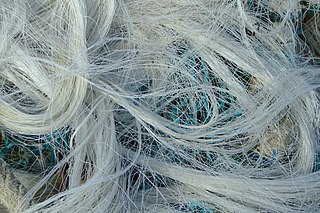
Monofilament fishing line is fishing line made from a single fiber of plastic material, as opposed to multifilament or braided fishing lines constructed from multiple strands of fibers. Most fishing lines are now nylon monofilament because they are cheap to produce and can be produced in a range of diameters which have different tensile strengths. Monofilament line is also manufactured in different colors, such as clear, white, green, blue, red, and fluorescent.

Polyglycolide or poly(glycolic acid) (PGA), also spelled as polyglycolic acid, is a biodegradable, thermoplastic polymer and the simplest linear, aliphatic polyester. It can be prepared starting from glycolic acid by means of polycondensation or ring-opening polymerization. PGA has been known since 1954 as a tough fiber-forming polymer. Owing to its hydrolytic instability, however, its use has initially been limited. Currently polyglycolide and its copolymers (poly(lactic-co-glycolic acid) with lactic acid, poly(glycolide-co-caprolactone) with ε-caprolactone and poly (glycolide-co-trimethylene carbonate) with trimethylene carbonate) are widely used as a material for the synthesis of absorbable sutures and are being evaluated in the biomedical field.

Ethicon, Inc. is a subsidiary of Johnson & Johnson. It was incorporated as a separate company under the Johnson & Johnson umbrella in 1949 to expand and diversify the Johnson & Johnson product line.
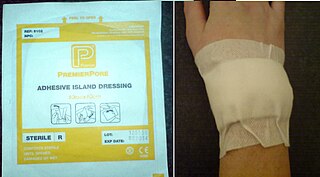
A dressing is a sterile pad or compress applied to a wound to promote healing and protect the wound from further harm. A dressing is designed to be in direct contact with the wound, as distinguished from a bandage, which is most often used to hold a dressing in place. Many modern dressings are self-adhesive.

Prolene is a synthetic, monofilament, nonabsorbable polypropylene suture. It is indicated for skin closure and general soft tissue approximation and ligation. Its advantages include minimal tissue reactivity and durability. Disadvantages include fragility, high plasticity, high expense, and difficulty of use compared to standard nylon sutures.
The history of wound care spans from prehistory to modern medicine. Wounds naturally heal by themselves, but hunter-gatherers would have noticed several factors and certain herbal remedies would speed up or assist the process, especially if it was grievous. In ancient history, this was followed by the realisation of the necessity of hygiene and the halting of bleeding, where wound dressing techniques and surgery developed. Eventually the germ theory of disease also assisted in improving wound care.
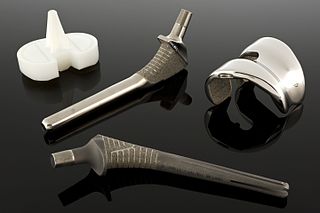
A biomaterial is a substance that has been engineered to interact with biological systems for a medical purpose, either a therapeutic or a diagnostic one. As a science, biomaterials is about fifty years old. The study of biomaterials is called biomaterials science or biomaterials engineering. It has experienced steady and strong growth over its history, with many companies investing large amounts of money into the development of new products. Biomaterials science encompasses elements of medicine, biology, chemistry, tissue engineering and materials science.
Davis & Geck was a surgical/medical device company founded in 1909 by Charles T. Davis and Fred A. Geck originally located in Brooklyn, NY.
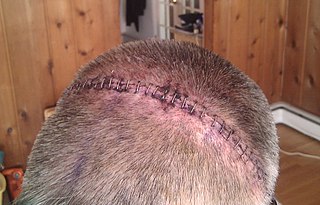
Surgical staples are specialized staples used in surgery in place of sutures to close skin wounds or connect or remove parts of the bowels or lungs. The use of staples over sutures reduces the local inflammatory response, width of the wound, and time it takes to close.

A surgical suture, also known as a stitch or stitches, is a medical device used to hold body tissues together and approximate wound edges after an injury or surgery. Application generally involves using a needle with an attached length of thread. There are numerous types of suture which differ by needle shape and size as well as thread material and characteristics. Selection of surgical suture should be determined by the characteristics and location of the wound or the specific body tissues being approximated.
Monocryl is a synthetic, absorbable suture manufactured in Cornelia, Georgia, USA, and trademarked by Ethicon. It is composed of poliglecaprone 25, which is a copolymer of glycolide and epsilon-caprolactone. It comes both dyed (violet) and undyed (clear) and is an absorbable monofilament suture.
Ethilon is a synthetic nonabsorbable nylon suture manufactured by Ethicon in Cornelia, Georgia. Black in color, it is a monofilament suture that is used frequently for soft-tissue approximation and ligation. Even though it is nonabsorbable, the knot security decreases over time and should not be used where permanent retention is required. Practitioners should exercise caution using such material in urinary and biliary tracts, as this can lead to calculi formation.
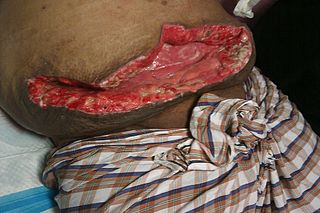
Wound dehiscence is a surgical complication in which a wound ruptures along a surgical incision. Risk factors include age, collagen disorder such as Ehlers–Danlos syndrome, diabetes, obesity, poor knotting or grabbing of stitches, and trauma to the wound after surgery.
In medicine, the term cheesewiring or cheesewire effect describes any process in which cells or intercellular matrix are dissected or extruded either by the material being pressed through a taut element, or by the tension of a taut element pulling through tissue. The procedure is typically conducted in a surgical setting.
A barrier membrane is a device used in oral surgery and periodontal surgery to prevent epithelium, which regenerates relatively quickly, from growing into an area in which another, more slowly growing tissue type, such as bone, is desired. Such a method of preventing epithelial migration into a specific area is known as guided tissue regeneration (GTR).

Catgut suture is a type of surgical suture that is naturally degraded by the body's own proteolytic enzymes. Absorption is complete by 90 days, and full tensile strength remains for at least 7 days. This eventual disintegration makes it good for use in rapidly healing tissues and in internal structures that cannot be re-accessed for suture removal.
Artificial ligaments are devices used to replace damaged ligaments. Today, the most common use of artificial ligaments is in anterior cruciate ligament reconstruction. Although autotransplantation remains the most common method of ligament reconstruction, numerous materials and structures were developed to optimize the artificial ligament since its creation in the World War I era. Many modern artificial ligaments are made of synthetic polymers, such as polyethylene terephthalate. Various coatings have been added to improve the biocompatibility of the synthetic polymers. Early artificial ligaments developed in the 1980s were ineffective due to material deterioration. Currently, the Ligament Advanced Reinforcement System (LARS) artificial ligament has been utilized extensively in clinical applications. Tissue engineering is a growing area of research which aims to regenerate and restore ligament function.
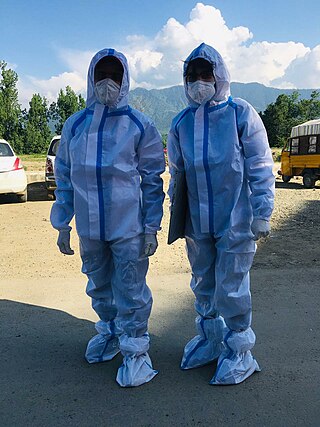
Medical textiles are various fiber-based materials intended for medical purposes. Medical textile is a sector of technical textiles that focuses on fiber-based products used in health care applications such as prevention, care, and hygiene. The spectrum of applications of medical textiles ranges from simple cotton bandages to advanced tissue engineering. Common examples of products made from medical textiles include dressings, implants, surgical sutures, certain medical devices, healthcare textiles, diapers, menstrual pads, wipes, and barrier fabrics.












